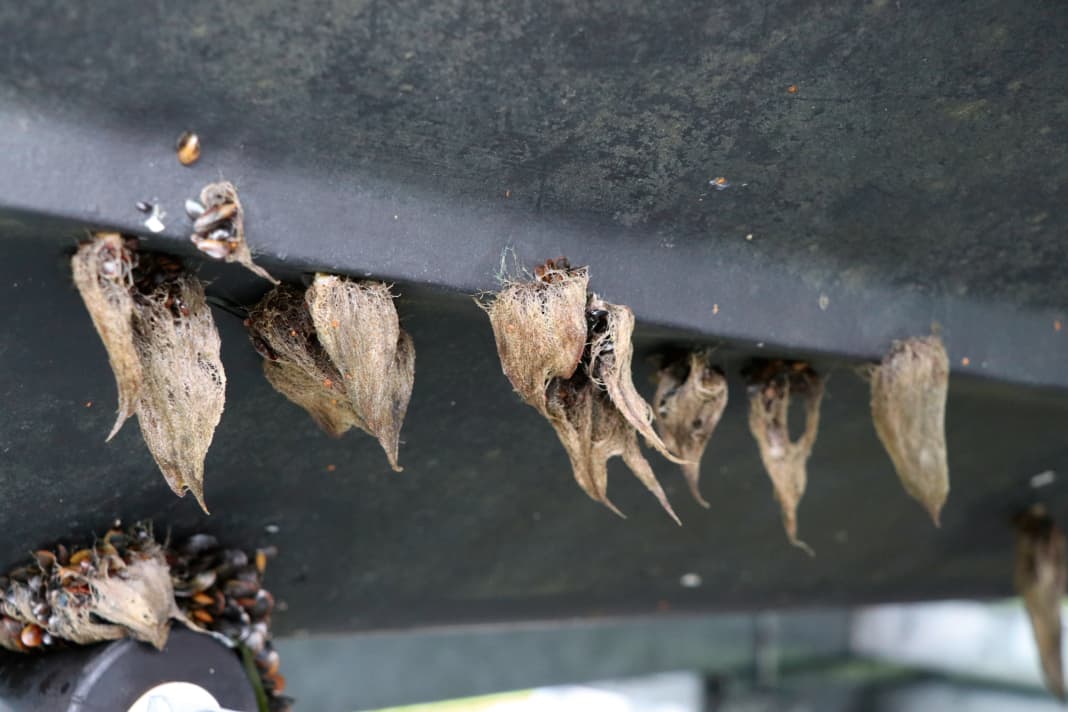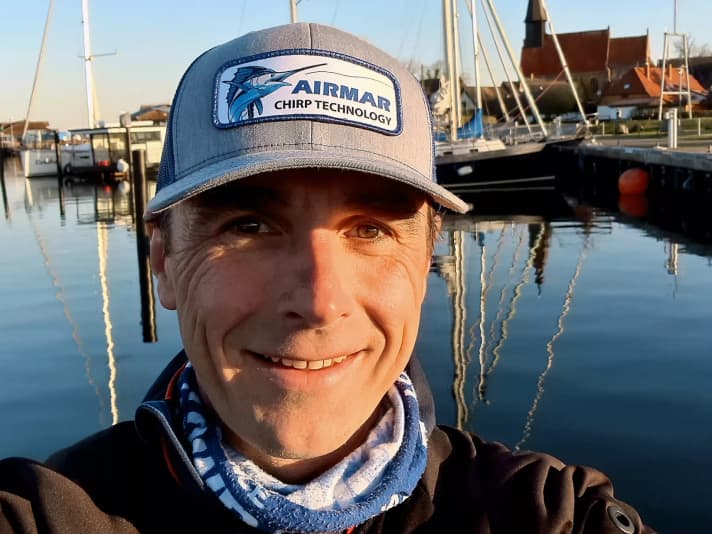





"It's really bad this season," Dirk Kehrhahn told BOOTE back in autumn 2021. He has been sailing on the Schlei from mid-April for over 15 years. Last year, however, his boat had to be taken out of the water at the end of July. The reason: the hull was full of pox.
"We currently have a lot of fouling on ship propellers, which is causing problems," reported Thedje Ancker, Managing Director of Ancker Yachting in Kappeln an der Schlei at the time. The neighbouring boat builders Janssen & Renkhoff reported a similar story: "We have smallpox without end." Yes, it was "definitely" worse than usual: rows of boats along the Schlei were craned out of the water in the middle of the season to get the plague under control. In the 2022 season, there were also corresponding reports from the North Sea.
Fortunately, it is not a mass phenomenon, at least not yet
So just isolated cases and therefore no cause for concern? In fact, the problem is more complex, as Thomas Zeller, Managing Director of antifouling and yacht paint manufacturer International, knows: "We've been aware of this for decades, especially in the Schlei and Trave." The problem has always been greater in these two brackish water areas than elsewhere in the Baltic Sea, says Zeller.
Sven Münch from the Yachticon Group, which sells the widely used Seajet antifouling, comes to similar conclusions. "No, there was no exceptionally large problem with smallpox in 2021," he assures; at least the feedback from his customers did not allow this conclusion to be drawn. In the Schlei and Trave, however, there are "frequent reports of heavy smallpox growth on yachts", which is typical of the area. "Basically, from my point of view, everything is the same as always," says Münch, who himself has a boat moored in the Schlei.
In places, the water temperature was eight degrees higher than usual at this time of year
However, the Baltic Sea became very warm relatively quickly last year; in July it was "warmer than many parts of the Mediterranean", explains Kiel meteorologist Sebastian Wache. At over 27 degrees in places, the water temperature was sometimes eight degrees above what is usual at this time of year.
The BSH's long-term observations show this impressively: in the past 30 years, the average surface temperature in the Baltic Sea in June was 12.6 degrees on average - but in 2021 it was 15.8 degrees. The water was also warmer than the long-term average in the previous months. This favours fouling, especially in the brackish water zones of the estuaries. Jan Grell attributes the problems experienced by boat owners on the Trave "to the very rapid rise in temperature". In addition, the nutrient and salt content of the water also play a decisive role in the growth of pox, explains Helge von der Linden.
If you drive more, you have less vegetation."
Another important factor is the intensity of use of the yachts: "The most important thing to prevent fouling is to sail the boats," says Thedje Ancker. Thomas Zeller from International sums it up in a simple formula: "Those who sail more have less fouling."
Without the right antifouling, smallpox cannot be controlled
So what can affected boat owners do? "The most important thing is to choose the right antifouling for your area," emphasises Thomas Zeller. He also advises boat owners "not to fiddle too much with the thickness of the coating". Instead of applying just a thin layer of antifouling, they should apply two or, in special cases, even three layers, as the manufacturers all recommend. After all, if you have to crane your boat because it has too much pox growth, you will end up paying significantly more than for two or three more cans of antifouling. And it's not just about being one knot faster. If the smallpox overgrows the ship's passages or the steering gear and propeller, "it can quickly become a safety risk," comments Zeller.
Anyone who only applies one layer of antifouling, such as self-polishing, typically has a problem from mid-July or August, he says, because it slowly degrades in the water over time.
"More and more often, boat owners are not applying enough antifouling," observes Sven Münch from Yachticon, "that's definitely a problem." Incorrectly selected coatings are also a "perennial problem": "Thin-layer antifouling, for example, is well suited for inland waterways, but definitely has no place on the Baltic Sea."
The Baltic Sea is considered to be an area with medium fouling, while the Schlei and Trave are even categorised as "difficult". An unsuitable antifouling may work in favourable conditions - but in a season with high water temperatures and low intensity of use of the boat, "the protection is often no longer sufficient".
Take care when cleaning mechanically with a scrubbing brush or spatula
The problem with a severe pox infestation is that there is virtually no alternative to craning. This is because: "Mechanical cleaning of the hull in the water is generally not permitted," explains Sven Münch. This would increase the amount of biocides entering the water. So you may have to ask the harbour master before using the scrubber from the dinghy or hiring a diver.
There is something else to bear in mind: If you scrape off the fouling, you may also damage the protective coating. And if antifouling still adheres to the painstakingly removed barnacle, it is considered hazardous waste, says Münch. After all: "Antifouling products today contain far fewer toxic biocides than they did 20 years ago." In addition, the rules for manufacturers are becoming increasingly strict, which is why a product can only have a half-life of two or three years - then the formulation changes again. Whether you use a self-polishing or a hard antifouling is not so decisive at this point: "There are no type-related differences." Basically, the following applies: With antifouling coatings described by the manufacturers as "self-polishing" or "self-grinding", the coating dissolves slowly; the toxic active ingredients are continuously released into the water. With hard antifouling coatings, the binder does not dissolve, only the toxic biocides are released.
Today, copper compounds are mainly used as biocides. Zinc oxide is also used, but is "not quite as effective", says Helge von der Linden. According to Thedje Ancker, boats with saildrives pose a particular problem: This requires an antifouling that is also suitable for aluminium. "But this is copper-free and therefore less effective."
Research is being carried out into alternatives to smallpox
And what about biocide-free antifouling? "There are products that can work if you apply them correctly - which is usually only possible for professional users," says Sven Münch. However, these do not usually prevent fouling. "But it is then easier to remove." Everyone wants a completely biocide-free product that guarantees the same level of protection against fouling even under difficult conditions and can still be painted outdoors at the end of March when the temperature is five degrees and the hull is damp. But: "Unfortunately, we're not there yet."
The company Nandatec from Itzehoe, among others, is currently researching biocide-free antifouling. Over a period of three years, ships are to be tested with biocide-free and nanoparticle-free coatings in various concentrations. Anyone who wants to can make their boat available for this, says company boss and biologist Dagmar Schneider. The initial findings are promising.
However, she has also found that the pox started "much earlier" last year. In addition to algae, mussels and barnacles, the Australian chalk worm is now growing in numbers (see interview below). It infests ship hulls en masse, but also jetties, buoys and quaysides. In the end, the main thing that helps against fouling is "regular sailing", says Sven Münch. However, long stays in your home port after an extended holiday cruise could even make the problem worse. This is especially true for self-polishing antifouling if the coating is too thin. The protective layer wears off during the summer cruise - and then the boat remains almost unprotected in the harbour for weeks, with even higher water temperatures.
"Mass spread"

Interview with Sven Hille, who works as a marine biologist at the Leibniz Institute for Baltic Sea Research in Warnemünde
How long has the Australian chalk tube worm been in the Baltic Sea?
It was detected in the Trave more than ten years ago and has also been present in the Warnow for several years. Initially, these were only isolated animals.
It's different now. How did this come about?
Since October 2020, we have been observing a mass spread on underwater ships and harbour facilities in the Unterwarnow for the first time; similar reports have been received from Emden. There have already been accidents there because steering gear was no longer operational. The lime tubeworm has also been found in Sweden. Overall, this came as no surprise to us - this organism is one of the 100 most important invasive species and has been spreading worldwide for 100 years thanks to shipping.
The Baltic Sea was warmer than usual in 2021. Does this inevitably lead to more fouling?
Pox development is primarily determined by the nutrient supply. Temperature also plays a role, but is not decisive; the organisms simply grow more slowly in cold water.
Does climate change play a role in the mass spread of the calcareous tubeworm?
It favours this development because the water is getting warmer. In addition, nutrient levels are changing due to climate change - heavy rainfall and industrial agriculture also play a role here. In addition, the calcareous tubeworm has a high tolerance for salinity and can be found in estuaries worldwide, including the Warnow, Schlei and Trave rivers. Potentially, it can still spread to Rügen or Usedom, but it is unlikely to spread much further east because the salt content will no longer be sufficient.
What do boat owners need to be prepared for in the future?
They were always happy when they survived the smallpox season. If the underwater hull remained clean until midsummer, the danger was averted: With smallpox, the first larvae appear in May, and there are more in the summer. However, the calcareous tubeworm still produces tubes of up to ten centimetres in length within a few weeks, even in September. It therefore grows faster and extends the growing season into the autumn.
Boaters can also report their observations themselves to the Leibniz Institute for Baltic Sea Research Warnemünde: sven.hille@io-warnemuende.de
This might also interest you:
- Counsellor: Renew antifouling
- Counsellor: You need these tools for winter storage

